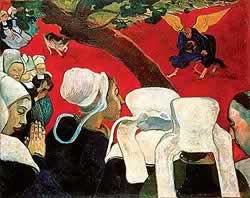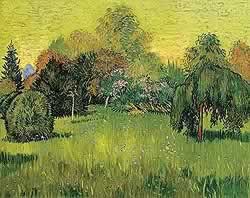
|
BRITANNY AND ARLES
Van Gogh and Gauguin left Paris in early 1888, both in search of destinations that would inspire creative impulses, crystallize their emerging artistic identities, and help them to realize their aims for a "new art." Gauguin moved to Brittany, where the rugged landscape and peasant life appealed to his desire for a simpler, more "primitive" existence far removed from urban Paris. Van Gogh left Paris’s cold, gray weather and followed the sun to the south of France, where the light and warmth offered an opportunity to explore his interest in color.
Once settled in the town of Arles, van Gogh embarked upon a project to establish a community of artists: he rented a home he called the "Yellow House," which would serve as a "Studio of the South" and invited Gauguin to join him there. In the months preceding Gauguin’s arrival, the two artists both exchanged letters outlining their creative strategies and painted prolifically, producing works such as van Gogh’s The Poet’s Garden and Gauguin’s The Vision of the Sermon. Both artists began to experiment with compositional techniques derived from Japanese art as well as the symbolic language of color, emphasizing subjective feelings and ideas over naturalistic representation. In the unfolding dialogue between them, each artist allowed his identity to emerge, their relationship developed, and a budding creative competition was born. Van Gogh viewed himself as a monk or disciple, spreading the word about a "new art," and looking to the older artist for leadership, while Gauguin perceived himself as a rebellious bohemian, a victim of society.

In October 1888, van Gogh and Gauguin exchanged self-portraits that revealed a great deal about how they perceived themselves and wished to be seen by others. In van Gogh’s austere portrait, his gaunt face, short hair, and beard allude to his belief in a monastic lifestyle and refer to his role as a monk (bonze) or humble disciple to Gauguin. The contrast of blue and yellow in the portrait echoes the colors in van Gogh’s painting of the yellow house and "the symphony in blue and yellow" in his sunflowers series.

Gauguin presented himself as an "outlaw" in his self-portrait, which specifically alludes to the noble character of Jean Valjean in Victor Hugo's novel Les Misérables. The bold lines of the figure and the vivid colors of the flowered wallpaper manifest Gauguin’s interest in "an abstract, symbolic style." Van Gogh, however, was disappointed when he received Gauguin’s Self-Portrait, believing that it expressed torment while failing to offer any hope or consolation. He even suggested to his brother Theo that the troubled Gauguin would benefit from a stay in the reinvigorating environment of Arles.

Gauguin moved away from Impressionism in this breakthrough painting from his Brittany period, a work that marks a high point in the development of his mature style. In the foreground, a group of pious local women and a priest experience an imaginary vision—the Old Testament story of Jacob wrestling with an angel, depicted in the upper right. The bold color, dramatic compositional devices (such as the diagonal tree trunk and tilted ground), and the exaggerated shapes of the women’s bonnets reveal Gauguin’s interest in abstraction, inspired by sources as varied as medieval stained glass and the art of Japan.

One of several paintings intended for Gauguin’s bedroom in Arles, The Poet’s Garden displays van Gogh’s brilliant use of color and texture to express the character of Provence—the southern province in which Arles is located. The thick, repetitive brush strokes that comprise the lemon-yellow sky and the lush, green foliage infuse this view of the garden across from the yellow house with great vitality. Van Gogh also hoped to imbue this picture with allusions to the 14th century, the golden age of Provence, and specifically to the famed Renaissance poet Petrarch (1304-1374), and the new "poet" of Provence, Gauguin.
Van Gogh and Gauguin: The Studio of the South has been organized by The Art Institute of Chicago and the Van Gogh Museum, Amsterdam. This exhibition is supported by an indemnity from the Federal Council on the Arts and the Humanities.
Van Gogh and Gauguin: The Studio of the South is part of the "Ameritech Exhibition Series" made possible through a grant from the Ameritech Foundation.
|








